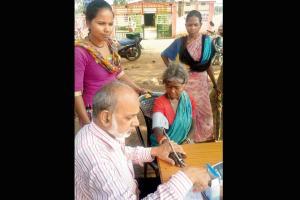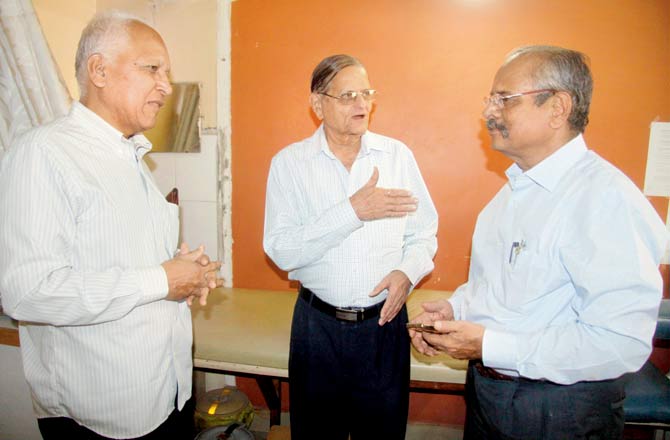A health survey by a group of retired doctors from Pune has revealed a direct link between the rise in lifestyle diseases among villagers in naxal-affected Chhattisgarh belt and distribution of free, subsidised food

Villagers participate in a health camp at a tribal village in Bastar
Government sops are meant to uplift the poor, but such goodwill doesn't seem to be working in the favour of tribal communities living in the naxal-affected Bastar district in Chhattisgarh. A recent survey conducted by doctors from the Diabetic Association of India (DAI) in Pune, has found a direct link between the alarming rise in lifestyle diseases among Bastar's villagers and distribution of free or subsidised food by the government. The reason: Free food is apparently making people lazier.
A group of retired doctors with DAI has been organising free health check-ups and surveys in tribal pockets across Maharashtra. Two years ago, after conducting a health survey in the Bhambaragadh and Hemalsakar areas of Gadchiroli in Maharashtra, the doctors were asked to carry out a similar drive in Chhattisgarh. On September 22 this year, a team comprising Dr Ramesh Godbole, Dr Mukund Kannur, Dr Bala Kulkarni, Dr Anil Kulkarni and Dr Neelkanth Khandkar from Pune, finally visited the villages of Barsur, Temaru Bhata, Muda Tikar, Salfi Bhata, Godel Aama, Madse and Erpund, in Dandewadi, Bastar.
ADVERTISEMENT
During the week-long health camp, around 300 men and women were examined. Of these, 7.61 per cent were diagnosed with borderline diabetes — a condition that develops before a person gets type 2 diabetes — and four per cent with diabetes. Further, 3.98 per cent of those surveyed, were found to have high blood pressure. It's only during interactions with the tribals that the doctors learned how the government had unwittingly contributed to the rise in illnesses among villagers.
Free, but at what cost?
Dr Godbole, who is a key member of the team, said that the way of life of the tribal community has changed in the last decade or so, especially after the Chhattisgarh government started distributing a monthly quota of free food to every family in the naxal-affected tribal belt. Speaking to mid-day, a villager from Dandewadi, on condition of anonymity, said that since 2010, every home in their village has been receiving 30 kg of rice, 5 kg of dal and 2 kg of sugar, each month. "Over and above this, if we have any additional requirements, we can buy rice [at R1 per kg] and sugar [at R7 per kg] from the nearby ration shop," the villager said. "We also receive subsidised cooking gas and have solar panels installed in our homes. So even when there's no electricity, we don't have to worry about lighting or heating," the villager added. Over and above this, educational and medical facilities have improved considerably, and are being made available free of cost.

The team of doctors that were part of the survey. Pic/Mandar Tannu
While villagers have benefitted from the government's benevolence, and the average lifespan has increased from 45 to 65, the quality of life seems to have taken a serious beating. Doctors feel that being provided subsidies has made the villagers, who traditionally farm and hunt, inactive. "They used to be involved in more physical activity before. They'd walk great distances into the forest to collect wood to light fire, and even climb perilous terrains to hunt for food. None of this happens anymore," said Dr Godbole. Scarcity of water in the rivers, has also hampered fishing activity.
Dietary changes have only made it worse. "Earlier, the tribal villagers would grow and eat seasonal vegetables, corn, nutritious cereals and fruits. But, abundant supply of free food — like rice, wheat and sugar — has caused a problematic shift in their dietary intake. The villagers are now consuming more carbohydrates, over proteins and other minerals." Another concern for the team of doctors is the increase in consumption of country liquor. The villagers previously used the flowers from madhuca indica, to prepare a popular alcoholic drink, known as mahua. It was enjoyed post an evening meal, and was said to be good for health. "However, we found out that most tribals are now addicted to country-made liquor, as it is easily available," said another doctor. Development in the name of roads and vehicles, has also increased pollution in the area. To make matters worse, pressure from the banned naxal outfit and police administration, has led to a spike in cases of hypertension, caused mostly due to stress.
Need for change
During the health camp, doctors also spoke with villagers and explained the need to incorporate tofu, soyabeans, corn, nachani and maize in their diet. "Lack of outdoor activities, means lack of exposure to sun, which is a rich source of Vitamin D, and accumulation of fat. Most of the diabetics were obese and pale, proving that physical activity is currently lacking," Dr Kannur said. Macrobiotic nutritionist Shonali Sabherwal said the need of the hour, is for governments to focus on health, as opposed to implementing thoughtless subsidies. "Rice and dal will definitely not sustain tribals. There is a need to focus on incorporating more leafy vegetables, which are rich in magnesium."
Commenting on the survey, Magsaysay Awardee Dr Abhay Bang, who is chairman of the Expert Committee on Tribal Health that has conducted studies across India, admitted that "tribal communities face the 'triple burden' of disease". "The advent of rapid urbanisation, and changing lifestyles and environment has led to a rise in non-communicable diseases as well cancer, diabetes, and hypertension. The lack of access to forests, loss of livelihoods, migration, acculturation and growing reliance on the public distribution system have also contributed to limiting their dietary diversity."
How finger millets saved the tribal kids of Palghar
Last year, celebrity nutritionist and author Rujuta Diwekar, who has an ancestral farm in Sonave village, Palghar, had noticed a rise in malnutrition cases among children from the tribal community there. Speaking to mid-day, Diwekar said, earlier the diet of the tribals comprised finger millet, a cereal crop, locally known as nagli. "With chips and soft drinks being readily available, several children were reported to have iron deficiency," she said.

In September 2017, Diwekar started a programme, where 120 kids from the tribal village of Baraf pada in Sonave, were served nagli kheer (finger millet porridge) at 8.30 am, before school. "The milk and nagli is locally sourced, the kheer is made by the agri women's bachat gat (small women's cooperative group) and it is served in my grandfather's ancestral farm. Over the last one year, we have seen a lot of positive changes in the children. The school teachers, too, claimed that the students do not fall ill that often. We hope that it makes the kids nutritionally stronger and financially boosts the women's groups," she said. At present, 250 children are benefiting from the health programme.
Catch up on all the latest Crime, National, International and Hatke news here. Also download the new mid-day Android and iOS apps to get latest updates
 Subscribe today by clicking the link and stay updated with the latest news!" Click here!
Subscribe today by clicking the link and stay updated with the latest news!" Click here!







